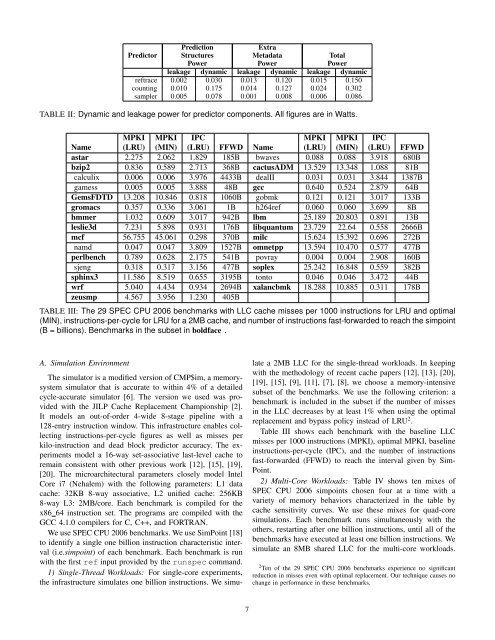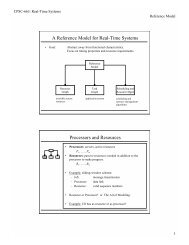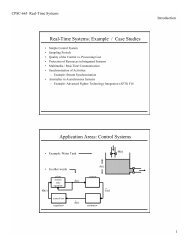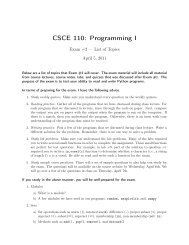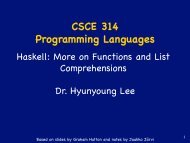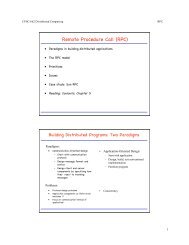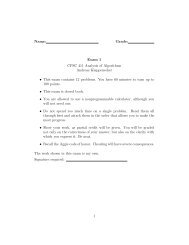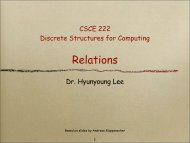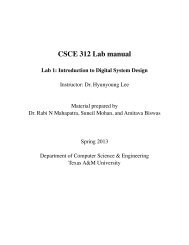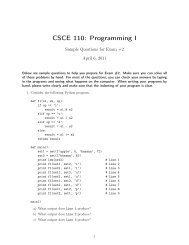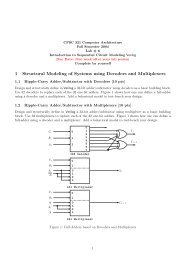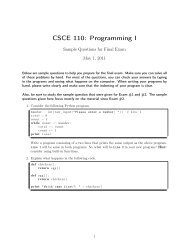Predictor Predictor Structures Cache Metadata Total Storagereftrace 8KB table 16 bits × 32K blocks = 64KB 72KBcounting 256 × 256 table, 5-bit entries = 40KB 17 bits × 32K blocks = 68KB 108KBsampler 3 × 1KB tables + 6.75KB sampler = 9.75 1 bit × 32K blocks = 4KB 13.75KBTABLE I: Storage overhead <strong>for</strong> the various predictorsD. Predictor PowerThe sampling predictor uses far less storage than the otherpredictors, but part of its design includes sets of associativetags. Thus, it behooves us to account <strong>for</strong> the potential impact ofthis structure on power. Table II shows the results of CACTI5.3 simulations [24] to determine the leakage and dynamicpower of the various components of each predictor. The samplerwas modeled as the tag array of a cache with as many setsas the sampler, with only the tag power being reported. Thepredictor tables <strong>for</strong> the pattern sample predictors was modeledas a tagless RAM with three banks accessed simultaneously,while the predictor table <strong>for</strong> the reftrace predictor was modeledas a single bank 8KB tagless RAM. The prediction table <strong>for</strong>the counting predictor was conservatively modeled as a 32KBtagless RAM. To attribute extra power to cache metadata,we modeled the 2MB LLC both with and without the extrametadata, represented as extra bits in the data array, and reportthe difference between the two.1) Dynamic Power: When it is being accessed, the dynamicpower of the sampling predictor is 57% of the dynamicpower of the reftrace predictor, and only 28% of the dynamicpower of the counting predictor. The baseline LLC itself hasa dynamic power of 2.75W. Thus, the sampling predictorconsumes 3.1% of the power budget of the baseline cache,while the counting predictor consumes 11% of it. Note thatCACTI reports peak dynamic power. Since the sampler isaccessed only on a small fraction of LLC accesses, the actualdynamic power <strong>for</strong> the sampling predictor would far lower.2) Leakage Power: For many programs, dynamic powerof the predictors will not be an important issue since theLLC might be accessed infrequently compared with otherstructures. However, leakage power is always a concern. Thesampling predictor has a leakage power that is only 40% ofthe reftrace predictor, and only 25% of the counting predictor.This is primarily due to the reduction in cache metadatarequired by the predictor. As a percentage of the 0.512W totalleakage power of the LLC, the sampling predictor uses only1.2%, while the counting predictor uses 4.7% and the reftracepredictor uses 2.9%.E. LatencyCACTI simulations show that the latency reading and writingthe structures related to the sampling predictor fit wellwithin the timing constraints of the LLC. It is particularly fastcompared with the reftrace predictor since it does not need toread/modify/write metadata in the LLC cache on every access.V. A DEAD-BLOCK DRIVEN REPLACEMENT AND BYPASSPOLICYWe evaluate dead block predictors in the context of acombined dead block replacement and bypassing optimization[11]. When it is time to choose a victim block, a predicteddead block may be chosen instead of a random or LRU block.If there is no predicted dead block, a random or LRU blockmay be evicted.If a block to be placed in a set will be used further in thefuture than any block currently in the set, then it makes senseto decline placing it [17]. That is, the block should bypassthe cache. Bypassing can reduce misses in LLCs, especially<strong>for</strong> programs where most of the temporal locality is capturedby the first-level cache. <strong>Dead</strong> block predictors can be used toimplement bypassing: if a block is predicted dead on its firstaccess then it is not placed in the cache.A. <strong>Dead</strong> <strong>Block</strong> Replacement and Bypassing with Default RandomReplacementIn Section VII, we show results <strong>for</strong> dead-block replacementand bypass using a default random replacement policy. Weshow that this scheme has very low overhead and significantper<strong>for</strong>mance and power advantages.What does it mean <strong>for</strong> a block to be dead in a randomlyreplaced cache? The concept of a dead block is well-definedeven <strong>for</strong> a randomly-replaced cache: a block is dead if it willbe evicted be<strong>for</strong>e it is used again. However, predicting whethera block is dead is now a matter of predicting the outcome ofa random event. The goal is not necessarily to identify with100% certainty which block will be evicted be<strong>for</strong>e it is usednext, but to identify a block that has a high probability of notbeing used again soon.B. Predictor Update in the OptimizationOne question naturally arises: should the predictor learnfrom evictions that it caused? We find that <strong>for</strong> reftrace and<strong>for</strong> the sampling predictor, allowing the predictor to learnfrom its own evictions results in slightly improved averagemiss rates and per<strong>for</strong>mance over not doing so. We believe thatthis feedback allows the predictor to more quickly generalizepatterns learned <strong>for</strong> some sets to other sets. On the other hand,we find no benefit from letting a tag “bypass” the sampler,i.e., tags from all accesses to sampled sets are placed into thesampler.VI. EXPERIMENTAL METHODOLOGYThis section outlines the experimental methodology used inthis study.6
<strong>Prediction</strong>ExtraPredictor Structures Metadata TotalPower Power Powerleakage dynamic leakage dynamic leakage dynamicreftrace 0.002 0.030 0.013 0.120 0.015 0.150counting 0.010 0.175 0.014 0.127 0.024 0.302sampler 0.005 0.078 0.001 0.008 0.006 0.086TABLE II: Dynamic and leakage power <strong>for</strong> predictor components. All figures are in Watts.MPKI MPKI IPC MPKI MPKI IPCName (LRU) (MIN) (LRU) FFWD Name (LRU) (MIN) (LRU) FFWDastar 2.275 2.062 1.829 185B bwaves 0.088 0.088 3.918 680Bbzip2 0.836 0.589 2.713 368B cactusADM 13.529 13.348 1.088 81Bcalculix 0.006 0.006 3.976 4433B dealII 0.031 0.031 3.844 1387Bgamess 0.005 0.005 3.888 48B gcc 0.640 0.524 2.879 64BGemsFDTD 13.208 10.846 0.818 1060B gobmk 0.121 0.121 3.017 133Bgromacs 0.357 0.336 3.061 1B h264ref 0.060 0.060 3.699 8Bhmmer 1.032 0.609 3.017 942B lbm 25.189 20.803 0.891 13Bleslie3d 7.231 5.898 0.931 176B libquantum 23.729 22.64 0.558 2666Bmcf 56.755 45.061 0.298 370B milc 15.624 15.392 0.696 272Bnamd 0.047 0.047 3.809 1527B omnetpp 13.594 10.470 0.577 477Bperlbench 0.789 0.628 2.175 541B povray 0.004 0.004 2.908 160Bsjeng 0.318 0.317 3.156 477B soplex 25.242 16.848 0.559 382Bsphinx3 11.586 8.519 0.655 3195B tonto 0.046 0.046 3.472 44Bwrf 5.040 4.434 0.934 2694B xalancbmk 18.288 10.885 0.311 178Bzeusmp 4.567 3.956 1.230 405BTABLE III: The 29 SPEC CPU 2006 benchmarks with LLC cache misses per 1000 instructions <strong>for</strong> LRU and optimal(MIN), instructions-per-cycle <strong>for</strong> LRU <strong>for</strong> a 2MB cache, and number of instructions fast-<strong>for</strong>warded to reach the simpoint(B = billions). Benchmarks in the subset in boldface .A. Simulation EnvironmentThe simulator is a modified version of CMP$im, a memorysystemsimulator that is accurate to within 4% of a detailedcycle-accurate simulator [6]. The version we used was providedwith the JILP Cache Replacement Championship [2].It models an out-of-order 4-wide 8-stage pipeline with a128-entry instruction window. This infrastructure enables collectinginstructions-per-cycle figures as well as misses perkilo-instruction and dead block predictor accuracy. The experimentsmodel a 16-way set-associative last-level cache toremain consistent with other previous work [12], [15], [19],[20]. The microarchitectural parameters closely model IntelCore i7 (Nehalem) with the following parameters: L1 datacache: 32KB 8-way associative, L2 unified cache: 256KB8-way L3: 2MB/core. Each benchmark is compiled <strong>for</strong> thex86 64 instruction set. The programs are compiled with theGCC 4.1.0 compilers <strong>for</strong> C, C++, and FORTRAN.We use SPEC CPU 2006 benchmarks. We use SimPoint [18]to identify a single one billion instruction characteristic interval(i.e.simpoint) of each benchmark. Each benchmark is runwith the first ref input provided by the runspec command.1) Single-Thread Workloads: For single-core experiments,the infrastructure simulates one billion instructions. We simulatea 2MB LLC <strong>for</strong> the single-thread workloads. In keepingwith the methodology of recent cache papers [12], [13], [20],[19], [15], [9], [11], [7], [8], we choose a memory-intensivesubset of the benchmarks. We use the following criterion: abenchmark is included in the subset if the number of missesin the LLC decreases by at least 1% when using the optimalreplacement and bypass policy instead of LRU 2 .Table III shows each benchmark with the baseline LLCmisses per 1000 instructions (MPKI), optimal MPKI, baselineinstructions-per-cycle (IPC), and the number of instructionsfast-<strong>for</strong>warded (FFWD) to reach the interval given by Sim-Point.2) Multi-Core Workloads: Table IV shows ten mixes ofSPEC CPU 2006 simpoints chosen four at a time with avariety of memory behaviors characterized in the table bycache sensitivity curves. We use these mixes <strong>for</strong> quad-coresimulations. Each benchmark runs simultaneously with theothers, restarting after one billion instructions, until all of thebenchmarks have executed at least one billion instructions. Wesimulate an 8MB shared LLC <strong>for</strong> the multi-core workloads.2 Ten of the 29 SPEC CPU 2006 benchmarks experience no significantreduction in misses even with optimal replacement. Our technique causes nochange in per<strong>for</strong>mance in these benchmarks.7


